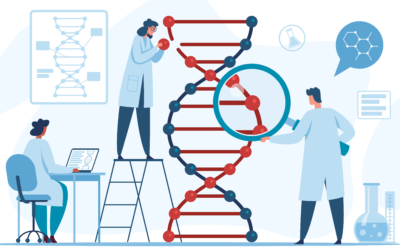Alzheimer’s disease (AD) is a progressive neurological disorder characterized by the accumulation of misfolded beta-amyloid and tau proteins in the brain. This accumulation leads to the deterioration of neuronal connections, resulting in cognitive decline and memory loss. Recent research has brought to light the significant role that glucose metabolism plays in the development and progression of Alzheimer’s. This article explores the findings on how impaired glucose metabolism, particularly in astrocytes and microglia, contributes to Alzheimer’s pathology.
Table of Contents
The Critical Role of Astrocytes in Brain Energy Supply
Astrocytes are a type of glial cell in the brain that play a crucial role in supporting neurons. One of their primary functions is to ensure that neurons receive an adequate supply of energy to maintain their activity. They achieve this by breaking down glucose into lactate, which neurons can then use as an energy source. This metabolic process is vital for sustaining the normal functioning of the brain, including processes like synaptic plasticity and memory formation.
In the context of Alzheimer’s disease, the ability of astrocytes to metabolize glucose and produce lactate is compromised. This decline in glucose metabolism has been observed in various brain regions affected by Alzheimer’s. Without sufficient lactate, neurons are deprived of an essential fuel source, which can lead to impaired neuronal function and accelerated cognitive decline. Understanding the mechanisms behind this metabolic disruption is crucial for developing effective treatments for Alzheimer’s disease.
IDO1 Enzyme: A Key Player in Glucose Metabolism and Alzheimer’s
Recent research has identified an enzyme called indoleamine-2,3-dioxygenase 1 (IDO1) as a key factor in the altered glucose metabolism observed in Alzheimer’s disease. A study led by Dr. Katrin Andreasson at Stanford University revealed that beta-amyloid and tau proteins can increase the levels and activity of IDO1 in astrocytes. This elevation in IDO1 is linked to a suppression of the conversion of glucose to lactate, thereby disrupting the energy supply chain from astrocytes to neurons.
The study demonstrated that by inhibiting IDO1, either through pharmacological intervention or genetic modification, the production of lactate could be restored in the presence of beta-amyloid and tau. This finding is significant because it suggests that IDO1 is a modifiable factor in the metabolic pathway. Targeting IDO1 could potentially restore normal glucose metabolism and support neuronal health, opening new avenues for Alzheimer’s treatment.
Impact on the Hippocampus: Memory and Synaptic Plasticity
The hippocampus is a critical region of the brain involved in learning and memory. In Alzheimer’s disease, this region is one of the first to show signs of damage, correlating with the early symptoms of memory loss and cognitive impairment. In various mouse models of Alzheimer’s, researchers found that lactate production in the hippocampus was significantly reduced, leading to impaired spatial memory and decreased synaptic plasticity. Synaptic plasticity refers to the brain’s ability to strengthen connections between neurons over time, a process essential for learning and memory.
By inhibiting IDO1, researchers were able to restore lactate production, spatial memory, and synaptic plasticity to normal levels in these mouse models. Interestingly, when the neurons were prevented from importing lactate, the inhibition of IDO1 did not restore synaptic plasticity, suggesting that lactate is a critical component for maintaining cognitive functions. This discovery underscores the importance of metabolic support provided by astrocytes to neurons and highlights the potential of targeting IDO1 as a therapeutic strategy for Alzheimer’s disease.
Human Relevance: Findings in Alzheimer’s Patients
To validate these findings in humans, the research team derived stem cells from individuals with and without late-onset Alzheimer’s disease. These stem cells were induced to form astrocytes and neurons, creating an in vitro model of Alzheimer’s. In astrocytes derived from Alzheimer’s patients, both glucose metabolism and lactate production were found to be reduced. Moreover, these astrocytes showed a diminished ability to transfer lactate to neurons, further depriving the neurons of this crucial energy source.
The inhibition of IDO1 in these human-derived astrocytes restored both lactate production and its uptake by neurons to normal levels. This suggests that the mechanisms observed in animal models also apply to humans, reinforcing the idea that targeting IDO1 and restoring lactate production could be a viable therapeutic approach. It opens up the possibility that addressing metabolic deficiencies in the brain could alleviate some of the cognitive impairments associated with Alzheimer’s disease.
Implications for Treatment: Targeting Metabolic Pathways
The research findings suggest that beta-amyloid and tau proteins increase the activity of IDO1 in astrocytes, thereby disrupting glucose metabolism and reducing lactate production. This reduction in lactate availability deprives neurons of an important energy source, contributing to the cognitive decline observed in Alzheimer’s patients. Restoring lactate production by inhibiting IDO1 offers a potential strategy to prevent or reverse the cognitive effects of the disease.
IDO1 inhibitors have already been developed for cancer treatment, making them potential candidates for repurposing in Alzheimer’s therapy. Since these drugs have already undergone some level of safety and efficacy testing, they may offer a quicker route to clinical application for Alzheimer’s patients. Additionally, this treatment approach could potentially extend beyond Alzheimer’s disease, as other neurodegenerative disorders may also involve similar metabolic disruptions.
A Common Mechanism in Neurodegeneration?
The involvement of glucose metabolism and IDO1 in Alzheimer’s raises the possibility that different neurodegenerative diseases may share common metabolic mechanisms. If metabolic disruption is a shared pathway, then therapies targeting these pathways could have broader applications. By focusing on restoring normal cellular metabolism, it may be possible to develop treatments that address not only Alzheimer’s but also other conditions like Parkinson’s disease and amyotrophic lateral sclerosis (ALS).
Future research is needed to further explore this hypothesis and to understand the full extent of IDO1’s role in neurodegeneration. Nevertheless, the current findings mark a significant step toward understanding the metabolic underpinnings of Alzheimer’s disease and offer hope for new treatment strategies that could improve the lives of those affected by this devastating condition.





0 Comments